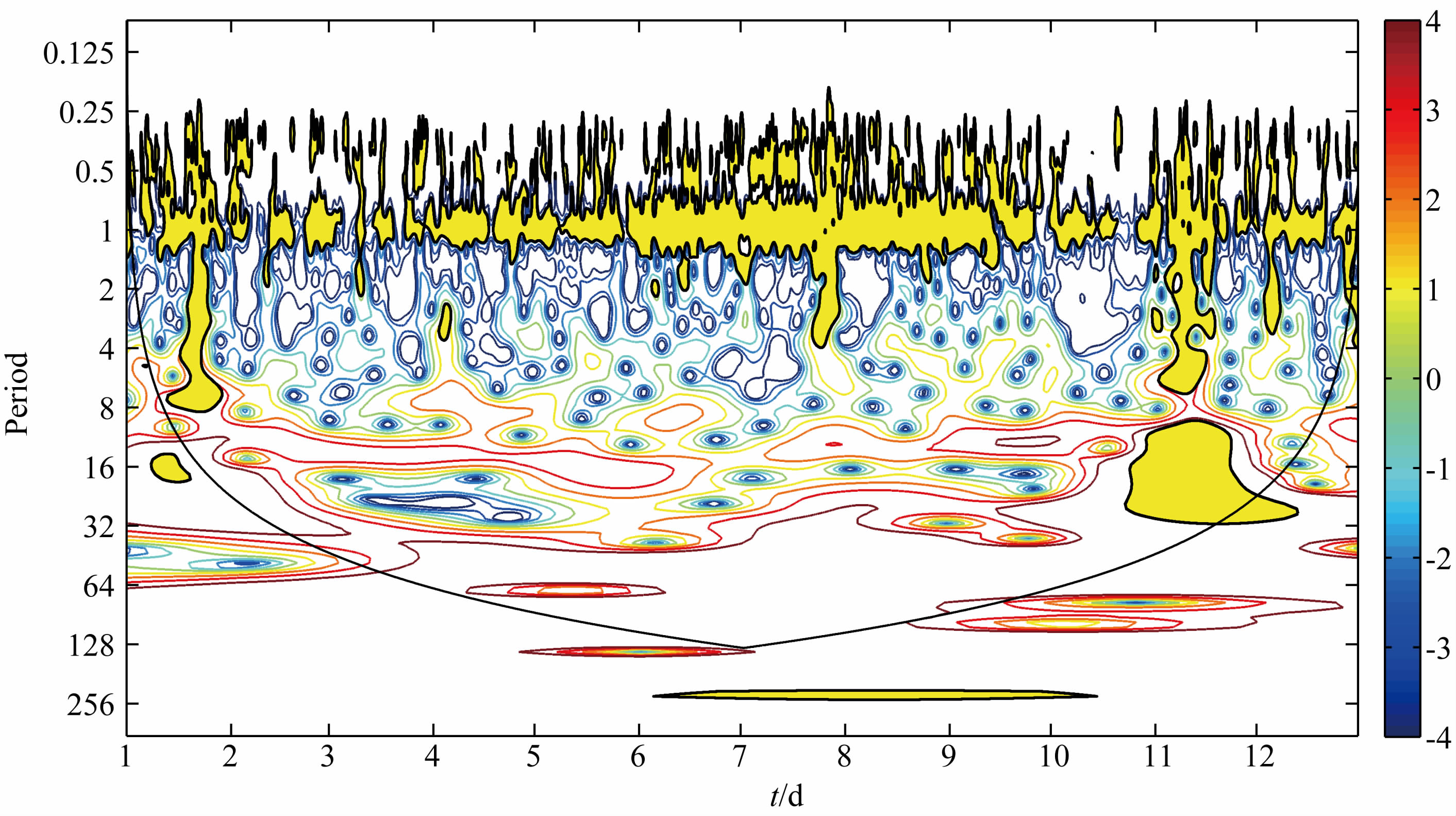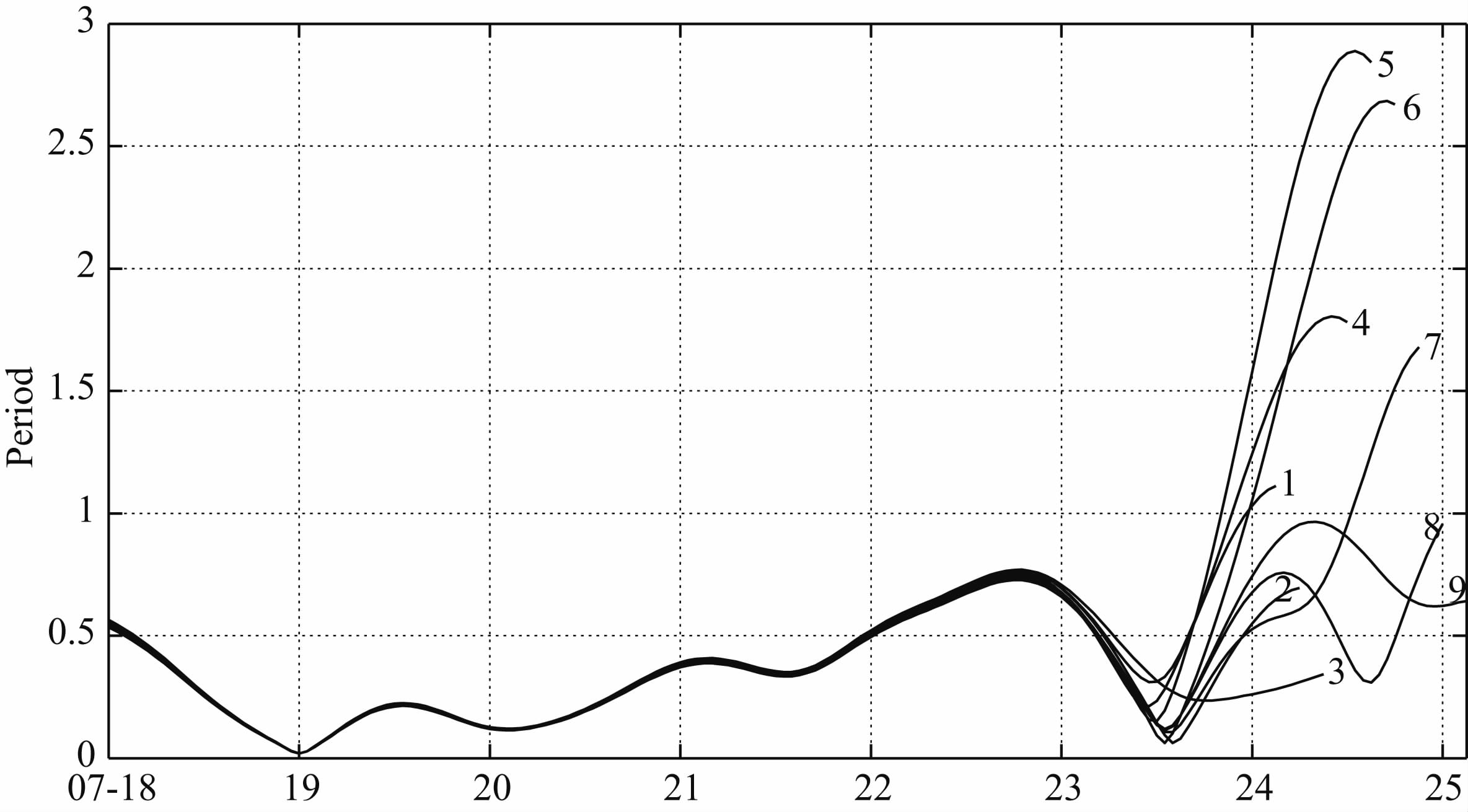2. 国家卫星气象中心, 北京 100081
2. National Satellite Meteorology Center, Beijing 100081, China
Periodic revolution is an important character of cosmic ray in which the 24h period is the most dominant during the quiet phase. When CME approaches the earth, the instinct regular pattern will be broken and other frequency grows. In this work, Morlet wavelet is applied to analyze the change in the character of cosmic ray intensity of the Beijing station (latitude: 40.04°N, longitude: 116.4°E, China), and key point is set to be the revolution of cosmic ray intensity. Before and after severe magnetic storms, three peculiarities are derived. Firstly, the 24 h periodicity exists and is distinct during quiet time. The module of Morlet wavelet of 12 h periodicity is of stability less than 0.6. Secondly, by analyzing the spectrum variation of wavelet before and after the great geomagnetic storm on 25th July, 2004 with a 90-days window, it is found that the 24 h periodicity was disrupted when the strong geomagnetic storm occurred, while the other different periodicity became obvious, especially fluctuation of 12 h periodicity. After further investigation, we find that fluctuation of 12 h periodicity became stronger a few hours to one day before the strong geomagnetic storm, which proves that the CME with the intensive magnetic field could highly alter the transportation and change the normal pattern of period distribution of cosmic ray. The verification with the all 13 events in 2002, 2004 and 2005 shows that all the modules of Morlet wave surpass 0.6. And finally, rapid increase in module of Morlet wavelet may become a precursor of a severe magnetic storm. Through applying module threshold to other storm events, the variation pattern of Morlet wave module is validated, and it is concluded that the threshold could be a useful factor in geomagnetic storm prediction.
Based on understanding of cosmic ray flux modulation process and principle as CME reaching, we think the flux of cosmic rays can produce abnormal fluctuations, and destroy the original period of 24 h. After analyzing the 12 h wave signal intensity changes of 13 strong geomagnetic storm events in 2002, 2004 and 2005, it is found the signal strength is increased significantly and quickly before the geomagnetic storm comes. After doing some statistics with all the severe geomagnetic events with Kp≥8 in 2002, 2004 and 2005, the Morlet wave module reached their maximum more than 5hrs before the storm commence. The method is tested with the all events in 2003 and the result turned out to be encouraging that 5 out of 6 (83%) great geomagnetic storms could be predicted and leading time was more than 10hrs. For the one absence, the author thought that the CME only played a partial role and high stream from coronal hole also a main factor because large coronal hole emerged that time and solar wind revolution exhibited come coronal property. This proved that the threshold of module could be the candidate parameter for prediction for severe geomagnetic storm.
Cosmic ray observation stations in Beijing received the cosmic ray flux. The period of 12 h abnormal increasing of wavelet signal mode can be an important precursor of a geomagnetic storm. It can be applied in the prediction of geomagnetic storms and used as an early warning of geomagnetic storms. This study suggests that the cosmic ray wave characters can be used to prognosis the properties of the coming CMEs be L1 satellites detect, which will improve the accuracy and leading time. More wave analysis methods and data from more cosmic ray stations are required for further investigations to this issue.
许多研究已经证明,CME是引起大地磁暴的驱动源(Kim et al.,2007;Wang et al.,2000;Webb et al.,2002).对于CME特征的认识,主要是通过日冕仪得到太阳附近的图像,而当CME进入行星际后,我们无法了解它在行星际的传播过程,也不能正确评估CME的对地有效性.我们能够再次感知CME,是它到达L1点,此时距离它对地球的影响只有30 min左右,因此没有足够的预警时间.CME不仅能够形成激波(涂传诒,1988),而且其内部的磁场也比周围强,因此能够改变穿过它的银河宇宙线的能量和运动方向(Richardson et al.,2000),特别是当CME接近地球时,将会引起银河宇宙线通量的异常扰动.
CME到达地球之前,在其携带的强磁场和激波作用下,宇宙线通量会发生扰动,很多大地磁暴之前宇宙线通量已经开始上升,这是由激波加速造成的,而宇宙线通量的Forbush下降则是由于地球处在激波后宇宙线通量的弱区(Kudela et al.,2001).通常Forbush下降之前的现象在地面不同的宇宙线观测台站的同一时间是相似的,通过研究分布在不同经度的中子观测资料可以发现,在地磁暴急始发生的几个小时前,宇宙线已经发生预先的增长或下降,而宇宙线的变化幅度根据探测位置的不同呈现出不同的形态,对此Belov等(1995)做了统计分析发现,如果在平静期宇宙线通量每日变化呈正弦特征,那么在一个纬度圈上,各台站将呈现出不同的变化趋势,表示不对称性的增加,而这种现象通常与地磁扰动有一定的联系.
CME接近地球时,不仅宇宙线会呈现出明显的上涨或下降的趋势,宇宙线通量的上下波动特征也更明显, 薛炳森等(2007)分析了Nagoya宇宙线闪烁体望远镜探测数据的变化特点,发现地面宇宙线通量在大地磁暴前的涨落幅度会出现异常增加现象.王晶等(2009)则定性地探讨了磁暴前后宇宙线各向异性的演化特征,发现大地磁暴前,东-西、南-北方向的各向异性指数的小波系数会达到一定阈值.这种宇宙线通量异常的波动现象被科学家称为 “宇宙线闪烁”(Kozlov and Tugolukov,1992).Kozlov和Tugolukov(1992)根据宇宙线的短时波动特性,提出了反映宇宙线快速变化指数,即“宇宙线闪烁指数”,根据该指数的分布确定了若干等级,经统计发现该指数的异常增长可以出现在地磁暴前的2~4 d,这也正是CME从太阳表面发出的信号.
Kudela等(2001)引入了单站谱密度指数,同样显示出与行星际激波的密切联系.由单个中子堆连续数据序列得到的谱密度指数经过统计,发现该指数可在地磁暴发生的12~32h之前出现突然增长.
大地磁暴来临前的宇宙线变化特征可以为大地磁暴的预报提供一种有效信息,因而宇宙线强度变化特征也正成为空间环境预报的有效手段之一.对宇宙线的研究方法有很多种,除了全球分布不对称性的分析外,对CME引起的宇宙线通量异常波动的分析也是一种重要的分析方法(Dorman,1965).主要包括傅里叶方法、最大熵方法等,但这些传统的方法得不到信号的局部时频特征.小波变换(Wavelet Transform,WT)是一种信号的时间-尺度(时间-频率)分析方法,具有多分辨率的特点,可以由粗到精逐步观察信号的变化,小波分析克服了傅里叶方法在时域上定位性的不足,而在时、频两域都具有表征信号局部特征的能力(刘珺和周德文,2007),因此能够将信号或图像分解成交织在一起的多尺度成分,并对不同尺度成分采用相应精度的时间域或空间域,从而能够不断聚焦到研究对象的任何微小细节.正是由于这些特点,小波分析在宇宙线波动特征的分析中也得到了应用.苗娟等(2003)通过宇宙线小波分析,发现1 h频率在几次大地磁暴前有异常增长,乐贵明等(2004)也采用小波分析研究了地磁暴前后的宇宙线频谱的变化特征.
大多数基于小波分析的宇宙线特征研究只是针对地磁暴前后的频谱变化,在进行小波分析时都将地磁暴的时段包含在内,这样总结出来的地磁暴前的宇宙线频谱特征包含地磁暴过程的影响,并未涉及地磁暴前小波频谱的动态变化,不能应用到地磁暴预报中.本文将利用子午工程北京宇宙线台站的宇宙线数据分析宇宙线特定频率的幅度变化,探索基于小波分析技术的大地磁暴预报方法.
2 方法分析和数据准备CME接近地球时,其前部的激波和携带的强磁场将使宙线粒子的原有运行轨道发生显著变化,造成到达地球的宇宙线通量发生扰动,这种扰动不仅表现在宇宙线台站计数大小的变化,频率特征也发生相应变化(Dorman et al.,1984;Morozova et al.,1984;Owens and Jokipii,1974; Sakai et al.,1985;Chowdhury,2011).Pérez等(1998)的工作进一步发现,宇宙线变化的功率谱在行星际激波到达地球前1 d左右,它的6~8 h频率附近的振幅会有异常增加,尽管在地磁平静期间也会出现类似的高频分量,但其幅度要小得多.此现象可以作为大地磁暴预报的先兆.
利用小波分析宇宙线通量波动的方法很多,在许多宇宙线特征研究工作中得到了应用(Nla et al.,2009;Caswell,2014;Kozlov and Markov,2007).本文选择Morlet小波方法,将它定义为
ψi>(t)=e-t2/2ejΩt.
Morlet小波不但具有非正交性而且在时间与频率的局部化之间有着很好的平衡,在许多工作中都被采用(Torrence and Compo,1998;Torrence and Webster,1999;Farge,1992;Grinsted et al.,2004).
在数据选用方面,主要采用了北京宇宙线台站的宇宙线监测数据,考虑北京宇宙线台站地处中纬(39.4°N),宇宙线计数率不高,短期内通量不确定性较大,因此时间精度取为1 h.北京宇宙线台站作为子午工程的主力台站,实现了宇宙线的实时监测和数据传输,可以实现数据的技术处理和分析,能够达到利用宇宙线数据进行大地磁暴预报/预警的数据要求.
3 宇宙线强度变化和地磁暴的相关分析在对北京宇宙线台站数据进行分析之前,要对数据的波动频谱的连续变化有全面的认识.将宇宙线通量的连续记录作为小波分析的信号,利用连续小波变换能够反映信号自身时间尺度变换特征,首先对宇宙线通量在在各种频率下信号的强弱进行整体分析.图 1显示的是2004年全年北京宇宙线台站的宇宙线通量数据的小波分析结果,图中区域越亮的地方代表此位置的功率谱越强,反映了宇宙线通量的主导波动组分时频变换的局部性和动态性特征,黑色粗实线圈闭的值通过了95%置信水平的红噪声检验,黑色细实线包络显示了COI(Cone of influence,小波影响锥,表示连续小波变换的数据边缘效应影响较大的区域)区域(王亚敏等,2011),该 曲线以外的功率谱由于受到边界效应影响而不考虑.

|
图 1 2004年Beijing站宇宙线Morlet小波变化 Fig. 1 The variation of Morlet wavelet of cosmic ray at Beijing station in 2004 |
从图 1可以看出,宇宙线小波分析功率谱的峰值主要集中在12~24 h周期,这符合宇宙线在平静期存在准24 h周期性的特征;但在1月下旬、7月下旬、11月上旬,除了表现出日变化之外,功率谱在低频部分也出现显著增强,甚至可以达到16d的周期,并且均通过了95%的显著性检验.通过与2004年的地磁活动记录(http://www.swpc.noaa.gov/ftpmenu/indices)对比发现,1月22日、7月25日和11月8日分别发生了强地磁暴,因此可以直观分析出北京宇宙线通量的Morlet小波分析特征与强磁暴的发生存在一定的联系.
图 2是以90 d为时间窗口长度,逐天往后进行的小波分析,长时间尺度上观察强磁暴来之临前的变化特征,显示强地磁暴发生的过程中,小波功率谱是如何变化的.其中2a为04-24—07-22,90 d期间小波功率谱特征,可以发现在强磁暴来临之前的平静期,功率谱的峰值主要集中在24 h周期区域,这与宇宙线静日存在准24 h周期性的特征相吻合;图 2b为04-25—07-23期间小波功率谱的特征,可以发现7月23日的小波功率谱已经打破了原有的平静期集中分布于24 h周期的规律,功率谱在低频部分显著增强,达到4d周期;同样观察图 2(c—f),发现功率谱分布在长周期的区域越来越多,并且随着强磁暴的来临,达到8d周期.这是由于在平静期24 h周期显著,对应小波功率谱具有较大的模值,而更长周期被掩盖,其对应的小波谱模值较小,未通过显著性检验.磁暴来临造成宇宙线的扰动,使得更长的周期性显示出来,对应长周期的小波功率谱模值增大,同时周期小于24 h的分量随着CME的接近也趋于活跃.

|
图 2 90天周期运用小波方法分析强地磁暴前后变化图 Fig. 2 The difference before and after great geomagnetic storm by wavelet analysis during 90 days as a period |
Morlet小波可以分别针对“模”、“实部”、“位相”等参数的变化,进行多方位研究.为了分析在强磁暴来临前的特征变化情况,本文将Morlet小波分析中的“模”数据提取出来做进一步的研究.
将图 1中2004全年的模数据异常与强地磁暴的发生时间进行对比,可以看出大于48 h周期尽管在大地磁暴前后变化显著,但这种增长几乎与强地磁暴同时出现,作为先兆,其预报提前量方面不足.而周期小于24 h的部分,尽管出现增强的时段较多,但大地磁暴之前的强度更大.因此本文选用固定频率12 h,将小波波模的变化与大地磁暴的发生时间进行对比分析,结果如图 3所示.

|
图 3 2004年小波“模”的变化(a)与Ap指数(b) Fig. 3 The variation of wavelet module(a) and Ap index(b) |
图 3是2004年全年Morlet小波在12h周期的“模”数据与Ap指数的对比图.由地磁观测数据发现,在1月22日、7月25日、11月7日分别发生了强地磁暴,Ap指数最高达到189,而对应小波模也在几次大地磁暴时急剧增大,这与图 1、2的结果相同.其中1月22日地磁暴的小波模变化与另外两次相比不是特别明显,但相较于背景数据还是有一定的变化.这说明宇宙线12 h与大地磁暴之间有着更强的对应关系.为了更加精细的分析小波模与强地 磁暴的相关性,仍以2004年7月为样本进行具体分析.
为了避免地磁暴事件之后的数据对预报的影响,下面针对2004年7月下旬强地磁暴事件前的北京宇宙线数据小波特征变化进行精细分析.参照同期的Ap指数,2004年7月25日Ap指数达到122,Kp最大为8,为强磁暴事件.选取北京宇宙线的数 据,从2004年7月25日事件前24 h开始,以2160 h(即90天)作为周期窗口进行连续分析,步长为3 h,向后依次类推进行精细分析,直到7月25日03 ∶ 00UT(事件发生时刻),这样避免了强地磁暴之后的持续影响.分析参数是周期为12 h信号的模,这次事件前的Morlet小波分析结果如图 4.

|
图 4 2004年7月强地磁暴事件前Morlet小波模的分析 Fig. 4 The analysis of Morlet wavelet module before great geomagnetic storm in Jul,2004 |
图 4以2004年7月的强地磁暴事件为例,显示了周期为12 h小波信号的模,以3 h为间隔,也就 是强磁暴前24 h(7月24日03 ∶ 00UT开始)小波模 的变化特征.图中曲线1是2004年4月25日 4 ∶ 00—7月24日3 ∶ 00(图只截取了7月25日前8天的变化情况)时间内的小波模的变化,曲线2是2004年4月25日7 ∶ 00—7月24日6 ∶ 00内的小波模结果,曲线3—9以此类推.可以明显发现小波模随着CME的接近,从24日12 ∶ 00开始快速增加,最高达到2.9,最大值(曲线5)时间为24日15 ∶ 00,这比强磁暴到来的时间提前了12个小时.这个特征反映了CME接近地球时,激波和CME所携带的强磁场影响了宇宙线原有的传播路径,造成宇宙线通量的不规则变化,使得宇宙线信号在特定频率上的突然增强,这种特性为强地磁暴的预报提供可能性.
为了确定CME引起的强磁暴前宇宙线的频谱是否具有相似的变化规律,选取2002、2004、2005三年的所有强磁暴事件进行分析,统计结果如表 1所示.可以看出,选取的3年中所有13次强地磁暴发 生前,周期为12 h的小波波模都有显著的增加.注意到2005年5月15日的强地磁暴之前,周期为12 h 的小波波模达到最大值的时间与地磁暴同步,但波模超过1,说明如果选取较低的波模阈值,这次事件也是可以预报的.因此,选取合理的波模阈值对地磁暴宇宙线先兆的应用非常重要,阈值选择过大会造成漏报,阈值选择过小又会造成误报较大.根据平静期和地磁暴前周期为12 h的小波波模的统计,将这个阈值定为0.6.可以看出,以此阈值作为地磁暴先兆,表 1中的强磁暴事件均可预报.
|
| 表 12002、2004、2005年强磁暴事件相关统计 Table 1Statistical analysis of great geomagnetic storm in 2002,2004 and 2005 |
为了验证所确定的周期为12 h的小波波模阈值在强地磁暴预报中的效果,下面将选择参加试验的2003年所有强磁暴事件,检验利用周期为12 h的小波波模进行预报的准确性.
4 预报检验运用前文小波分析的方法和得到的阈值0.6,对2003年所有强地磁暴事件进行预报检验,结果如表 2.
|
| 表 2对2003年预报强地磁暴事件验证分析 Table 2The verification of prediction great geomagnetic storm in 2003 |
由表 2可知,2003年共发生了6次强磁暴事件,其中5次事件达到阈值,预报准确率为83%.另外,预报的时间提前量也是地磁暴预报的重要指标,5次地磁暴前,宇宙线12 h波动的“模”达到阈值的时间比地磁暴的发生都超前了12 h以上,有的达到24 h提前量,符合预报要求.但2003年11月20日的地磁暴前宇宙线波动却没有达到阈值,通过宇宙线数据比对发现,该次事件的Forbush下降的幅度不足5%,明显弱于其他地磁暴,而且,强地磁暴发生时,正与冕洞高速流影响地球的时段相重合,可以认为这次强地磁暴是两种机制叠加的结果,这种叠加所形成的地磁暴事件在太阳活动下降期较为普遍,因此,此次强地磁暴发生之前宇宙线扰动不够明显.这也提示我们,需要深入研究上述混合型的地磁暴的宇宙线先兆特征.
5 结论和展望基于CME接近时对宇宙线通量调制过程和原理的认识,我们认为CME到达地球附近时,宇宙线在CME伴随的激波和强磁场的影响下,其通量会发生异常波动,破坏原有的准24 h周期.本文利用Morlet小波变换对北京宇宙线台站的地面宇宙线数据在地磁暴前的变化特征进行分析,发现大地磁暴前大于和小于24 h频率的波信号都有显著增强.本文针对2002、2004和2005年所有Kp≥7的13次强地磁暴前的12 h波信号的强度变化进行递进分析,发现大地磁暴前信号强度会出现显著且快速的增加.进而统计分析选定信号强度0.6作为阈值,利用该阈值对2003年的6次大地磁暴进行预报检验,准确率达到83%(5/6),而且提前量满足大地磁暴预报/预警需求,证明利用该方法能够对强地磁暴作出预报.
以上是对北京宇宙线台站的数据在特定频率上的波动特征进行了详细分析,初步认为,北京宇宙线台站宇宙线通量所得到的周期为12 h的小波信号波模的异常增加可以作为大地磁暴预报的重要先兆,能够在大地磁暴的预报/预警工作中加以应用.
通过研究的进一步深入,我们认识到上述结论只是基于北京宇宙线单台站数据的分析基础上得出的,而且主要分析的是12 h固定频率的波动特征.实际上,宇宙线的波动包含了大量CME的间接信息,是判断CME对地影响的重要手段.今后将继续深入分析宇宙线台站数据在其他频率上的波动特性,挖掘这些特征形成的内在机理.本文重点探究了强地磁暴的预报,对小、中地磁暴的预报并未进行讨论,今后将对其他宇宙线台站的观测资料进行综合分析,争取能针对小、中、强地磁暴作出相应预报,为开发基于宇宙线数据的地磁暴预报模型提供更多理论和技术基础.
致谢 子午工程北京宇宙线台提供了宇宙线中子探测数据,美国空间天气预报中心(SWPC)提供Kp指数数据.
| [1] | Belov A V, Dorman L I, Eroshenko E A, et al.1995. Anisotropy of cosmic rays and Forbush decreases in 1991.//Proceedings of 24th International Cosmic Ray Conference, 4: 912-914. |
| [2] | Caswell J M. 2014. Combination of wavelet analysis and artificial neural networks applied to forecast of daily cosmic ray impulses. International Letters of Chemistry, Physics and Astronomy, 34: 55-63. |
| [3] | Chowdhury P. 2011. Study on solar and cosmic ray activities and their periodic behaviour.//Proceedings of the 29th Meeting of the ASI Conference Series, Vol. 3, 69-74. |
| [4] | Dorman L. 1965. Variation of Cosmin Ray (in Chinese). Beijing: Science Press. |
| [5] | Dorman L I, Libin I Y. 1984. Cosmic-ray scintillations and dynamic processes in space. Space Sci. Rev., 39(1-2): 91-152. |
| [6] | Farge M. 1992. Wavelet transforms and their applications to turbulence. Annual Review of Fluid Mechanics, 24(1): 395-458. |
| [7] | Grinsted A, Moore J C, Jevrejeva S. 2004. Application of the cross wavelet transform and wavelet coherence to geophysical time series. Nonlinear Processes in Geophysics, 11(5-6): 561-566. |
| [8] | Kim K H, Moon Y J, Cho K S. 2007. Prediction of the 1-AU arrival times of CME-associated interplanetary shocks: Evaluation of an empirical interplanetary shock propagation model. J. Geophys. Res., 122(A5), doi: 10.1029/2006JA011904. |
| [9] | Kozlov V I, Tugolukov N. 1992. Intensity scintillations of cosmic rays. I-Verification. Aeron, 32: 153-156. |
| [10] | Kozlov V I, Markov V V. 2007. Wavelet image of a heliospheric storm in cosmic rays. Geomagnetism and Aeronomy, 47(1): 52-61. |
| [11] | Kudela K, Storini M, Antalova A, et al. 2001. On the wavelet approach to cosmic ray variability. Proceedings of the 27th ICRC, 3773. |
| [12] | Le G M, Ye Z H, Yu S H, et al. 2004. Wavelet analysis of the cosmic ray intensities at Guangzhou muon station during January 7-11, 1997. Chinese J. Geophys. (in Chinese), 47(2): 190-194. |
| [13] | Liu J, Zhou D W. 2007. Application of wavelets analysis in the variation of cosmic ray with time. Journal of Henan Institute of Education (Natural Science) (in Chinese), 16(2): 9-11. |
| [14] | Miao J, Xue B S, Ye Z H. 2003. The wavelet character of cosmic ray intensity before geomagnetic stroms. Chin. J. Space Sci. (in Chinese), 23(6): 452-458. |
| [15] | Morozova E I, Pissarenko N F, Riedler W, et al. 1984. The magnetic field turbulence near interplanetary shock fronts. Advances in Space Research, 4(2-3): 331-334. |
| [16] | Owens A J, Jokipii J R. 1974. Cosmic Ray Scintillations: 3. The low-frequency limit and observations of interplanetary scintillations. J. Geophys. Res., 79(7): 907-912. |
| [17] | Prez-Peraza J, Leyva-Contreras A, Libin I Y. 1998. Prediction of interplanetary shock waves using cosmic ray fluctuations. Geofísica Internacional, 37(2): 87-93. |
| [18] | Richardson I G, Dvornikov V M, Sdobnov V E, et al. 2000. Bidirectional particle flows at cosmic ray and lower (-1 MeV) energies and their association with interplanetary coronal mass ejections/ejecta. J. Geophys. Res, 105(A6): 12579-12591. |
| [19] | Sakai T, Kato M, Takei R, et al. 1985. Periodic variations of cosmic ray intensity with period of about 37 minutes observed on April 25th, 1984. J. Geomagn. Geoelectr., 37(6): 659-666. |
| [20] | Tu C Y. 1988. Solar Terriscial Physics(in Chinese). Beijing: Science Press. |
| [21] | Torrence C, Compo G P. 1998. A practical guide to wavelet analysis. Bulletin of the American Meteorological Society, 79(1): 61-78. |
| [22] | Torrence C, Webster P J. 1999. Interdecadal Changes in the ENSO-Monsoon system. Journal of Climate, 12(8): 2679-2690. |
| [23] | Wang J, Liu S Q, Xue B S, et al. 2009. Anisotropy analyses of cosmic ray before the geomagnetic storm on Sep. 24, 1998. Chin. J. Space Sci. (in Chinese), 29(5): 495-501. |
| [24] | Wang Y M, Ye P Z, Wang S, et al. 2001. A statistical study on the geoeffectiveness of Earth-directed coronal mass ejections from March 1997 to December 2000. J. Geophys. Res., 107(A11): SSH 2-1-SSH 2-9. |
| [25] | Wang Y M, Zhang B, Guo L X, et al. 2011. Cross wavelet analysis and R/S analysis of relationship between geomagnetic Ap index and sunspot number. Scientia Geographica Sinica (in Chinese), 31(6): 747-752. |
| [26] | Webb D F. 2002. CMEs and the solar cycle variation in their geoeffectiveness.//Proceedings of the SOHO 11 Symposium on From Solar Min to Max: Half a Solar Cycle with SOHO, 409-419. |
| [27] | Xue B S, Ye Z H, Gong J H. 2007. Preliminary attempt in prediction the geomagnetic storm with ground cosmic ray data. Chin. J. Space Sci. (in Chinese), 27(3): 218-222. |
| [28] | Zarrouk N, Bennaceur R. 2009. A wavelet based analysis of cosmic rays modulation. Acta Astronautica, 65(1-2): 262-272. |
| [29] | 乐贵明, 叶宗海, 余少华等. 2004. 1997年1月7日至11日广州站宇宙线强度变化特征的小波分析. 地球物理学报, 47(2): 190-194. |
| [30] | 刘珺, 周德文. 2007. 小波分析在宇宙线随时间变化中的应用. 河南教育学院学报,16(2):9-10. |
| [31] | 苗娟, 薛炳森, 叶宗海. 2003. 地磁暴前地面宇宙线强度变化Morlet小波特征分析. 空间科学学报, 23(6): 452-458. |
| [32] | 涂传诒. 1988. 日地空间物理学. 北京: 科学出版社. |
| [33] | 王晶, 刘四清, 薛炳森等. 2009. 1998年9月24日地磁暴前宇宙线各向异性特性分析. 空间科学学报, 29(5): 495-501. |
| [34] | 王亚敏, 张勃, 郭玲霞等. 2011. 地磁Ap指数与太阳黑子数的交叉小波分析及R/S分析. 地理科学, 31(6): 747-752. |
| [35] | 薛炳森, 叶宗海, 龚菊红. 2007. 利用地面宇宙线强度变化预报地磁暴方法初步研究. 空间科学学报, 27(3): 218-222. |
 2015, Vol. 58
2015, Vol. 58


